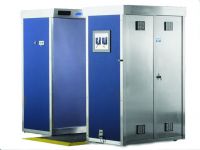 The TSA has announced that it plans to remove all x-ray (or backscatter, as it’s also known) body scanners and use only the radio-wave based scanners. The backscatter technology has received much criticism over health concerns and a lack of scientific testing to show they’re safe, and while the TSA finally started investigating the health risks associated with those machines in December of 2012, they say the decision to stop using these machines is due to the company’s inability to provide a timely software upgrade that would replace the actual image of the passenger with an avatar or other abstract graphical representation.
The TSA has announced that it plans to remove all x-ray (or backscatter, as it’s also known) body scanners and use only the radio-wave based scanners. The backscatter technology has received much criticism over health concerns and a lack of scientific testing to show they’re safe, and while the TSA finally started investigating the health risks associated with those machines in December of 2012, they say the decision to stop using these machines is due to the company’s inability to provide a timely software upgrade that would replace the actual image of the passenger with an avatar or other abstract graphical representation.
I’d written about the concerns with backscatter technology previously, and am hesitant to get too excited about this news. My concern now is that the study into the health effects will be terminated (as it should, to save money), yet OPI Systems (the backscatter scanner manufacturer) will upgrade their software and slightly change their hardware to allow them to release a ‘new’ model of scanner later this year which the TSA will then accept as a replacement for the 174 backscatter machines currently due to be sent back to OPI. Since it’s a ‘new’ machine, it’ll restart the clock, so to speak, for getting the TSA to begin investigating the health impact of it, then there will be a long, protracted study, etc, with the technology being used all the while. Of course, that’s just my pessimistic speculation..for now, it’s a victory for health as the machines are due to be removed and replaced with a safer technology.If you’re curious..check out this link for a good side by side comparison of the two scanner technologies.
